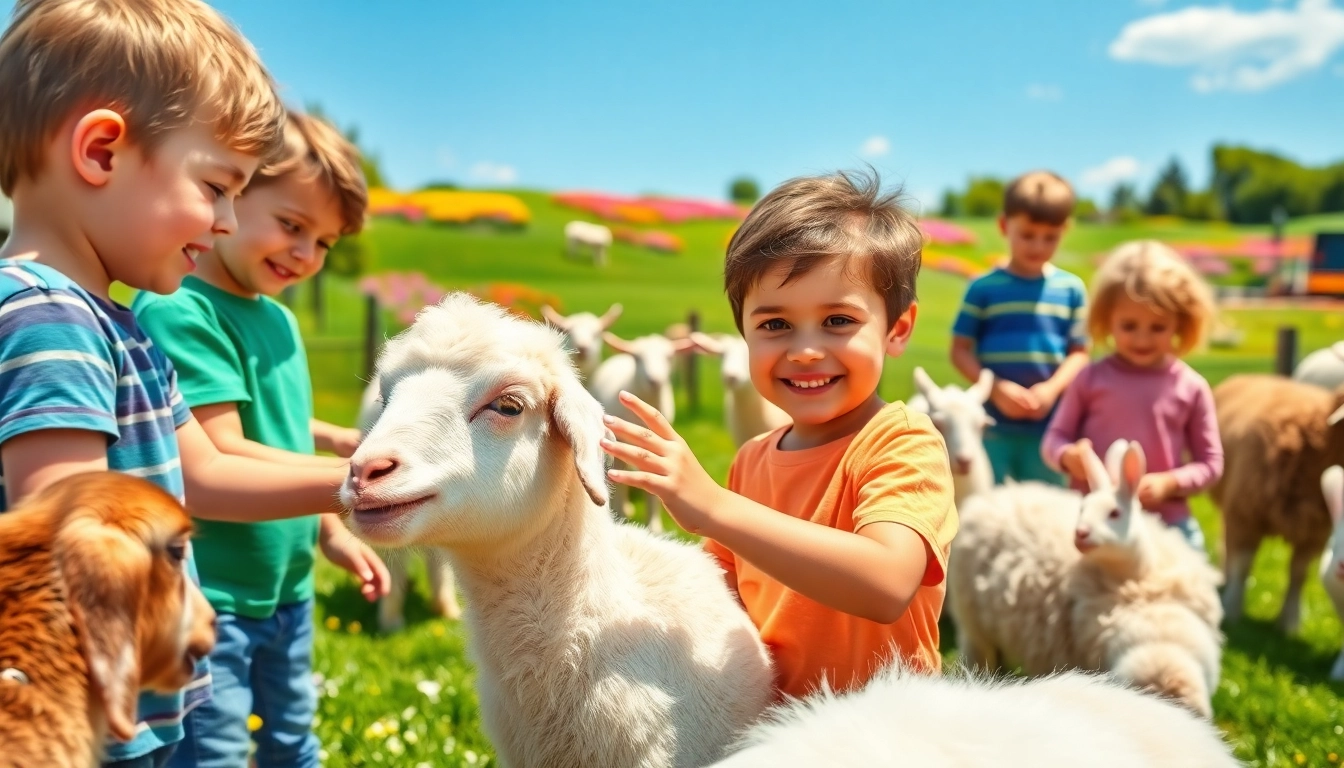Understanding What a Petting Zoo Is
Definition and Types of Petting Zoos
A petting zoo is an interactive venue where visitors, especially children, can pet and feed domesticated animals and sometimes even exotic creatures in a safe, supervised environment. These unique facilities can vary greatly; some are established as fixed locations, while others operate as mobile units that travel to schools, parties, and events. The primary goal of a petting zoo is to educate visitors about animals in a hands-on manner while fostering a sense of empathy and responsibility towards them.
There are generally two types of petting zoos: traditional petting zoos and specialty petting zoos. Traditional petting zoos feature a mix of common farm animals—like goats, sheep, and cows— along with friendly species like rabbits and chickens. Specialty petting zoos, on the other hand, might focus on exotic animals, offering unique experiences with species such as kangaroos, capybaras, and even lemurs. The variety of animals can turn a simple visit into a remarkable adventure that sparks curiosity in visitors of all ages.
Common Animals Found in a Petting Zoo
Petting zoos typically host a wide range of animals, which can include:
- Goats: Known for their friendly demeanor, goats are often the stars of petting zoos. They are playful and enjoy interacting with visitors.
- Sheep: Soft and gentle, sheep are another favorite and often participate in shearing demonstrations.
- Rabbits: These sociable creatures are available for petting, providing a gentle experience for young children.
- Chickens: Many petting zoos educate visitors on where their food comes from, featuring chickens as part of the experience.
- Pigs: Known for their intelligence, pigs can often be seen snuffling around, eager to engage with visitors.
- Exotic Animals: Many facilities also feature species such as kangaroos, mini donkeys, and, in some cases, even reptiles for a unique hands-on learning experience.
Benefits of Visiting a Petting Zoo
Visiting a petting zoo comes with a plethora of benefits. From fostering a love of animals to enhancing educational experiences, petting zoos offer unique advantages:
- Hands-On Learning: Children and adults alike can learn about animal care, behavior, and nutritional needs by interacting directly with the animals.
- Development of Empathy: Interactions with animals help build emotional connections, promoting kindness and compassion toward all living beings.
- Physical Activity: Engaging with animals often involves walking, grooming, and feeding, contributing to a more physically active lifestyle.
- Social Interaction: Visiting petting zoos fosters not only connections between people and animals but also between the visitors themselves—creating opportunities for families and friends to bond.
- Therapeutic Benefits: Animal-assisted interactions can have calming effects and can reduce anxiety levels in many individuals, including children with special needs.
Planning Your Trip to the Petting Zoo
Choosing the Right Petting Zoo for Your Family
Choosing the right petting zoo can significantly enhance your experience. Consider the following factors:
- Location: Is the petting zoo easily accessible? Proximity can save travel time and help families with young children.
- Animal Variety: Research the types of animals available. If your children have specific favorites, confirm they’re included in the zoo’s offerings.
- Safety Features: Look for petting zoos that prioritize safety, such as proper enclosures and clean facilities, ensuring a secure environment.
- Reviews and Recommendations: Seek out reviews from other visitors. These can provide insights into customer satisfaction and the overall experience.
Best Times to Visit a Petting Zoo
The best time to visit a petting zoo can depend on various factors. Generally, early morning or late afternoon during weekdays tends to be less crowded. Weekends are typically busier, especially during peak seasons like summer and holidays. For those looking for a quieter experience, consider planning your visit during school hours.
Moreover, inquire if the petting zoo has special events, as these attract larger crowds. Knowing their schedule can help you choose the optimal time for your visit.
What to Expect During Your Visit
Upon arriving at a petting zoo, expect to be greeted by not only the staff but also the excited sounds of animals. Most facilities provide guided tours or offer opportunities for self-guided exploration. Be prepared for a hands-on experience where you can pet, feed, and learn about various animals. Staff members are usually available for guidance, sharing interesting facts and caretaking details about the animals.
In addition to animal interactions, petting zoos often host demonstrations, such as sheep shearing or animal training sessions, providing an educational dimension to your visit. Facilities may have picnic areas, gift shops, or snack bars for refreshments, making it a full day of fun activities.
Preparing for a Visit to the Petting Zoo
Essential Items to Bring
Before heading out, it’s important to prepare by packing some essential items:
- Comfortable Clothing: Opt for casual, breathable clothes suitable for exploring outdoor spaces.
- Sunscreen and Hats: Protect yourself from sun exposure, especially during the warmer months.
- Water Bottles: Hydration is key, particularly during outdoor activities. Carry water bottles to keep everyone refreshed.
- Hand Sanitizer: Keeping hand sanitizer on hand is wise after handling animals for health and hygiene purposes.
- Camera: Bring a camera or smartphone to capture memorable moments together with the animals.
Dress Code for a Day at the Petting Zoo
Dressing appropriately can greatly enhance your experience at a petting zoo. Here are some tips:
- Closed-Toe Shoes: Wear comfortable shoes that can withstand walking on various surfaces, including dirt and grass.
- Layer Up: Depending on the weather, layer clothing may be necessary, as temperatures can vary throughout the day.
- Practical Accessories: Sunglasses and hats can help shield you from the sun, providing comfort during outdoor activities.
Safety Guidelines to Follow
Observing safety guidelines is crucial for a positive experience. Some key considerations include:
- Supervision: Always supervise children around animals; ensure they know not to approach aggressive or skittish animals.
- Feeding Rules: Only feed animals designated food provided by petting zoo staff to avoid causing them harm.
- Health Precautions: Maintain personal hygiene by sanitizing hands frequently, especially after interactions with animals.
- Respect Boundaries: Understand that not every animal will want to be petted. Pay attention to their body language to gauge their comfort level.
Engaging Activities at the Petting Zoo
Interactive Feeding Experiences
Interactive feeding is one of the hallmarks of visiting a petting zoo. Many facilities allow guests to purchase specialized food or treats to feed to animals. These experiences can create unforgettable memories, where you can witness animals interacting with people, showcasing their playful behavior.
Typically, animals like goats, sheep, and cows respond very positively to feeding activities, allowing visitors to connect on a deeper level. Take the opportunity to learn about their eating habits and digestive systems, enhancing your educational experience.
Animal Care Workshops
Some petting zoos offer educational workshops that teach visitors how to care for animals. These workshops might cover grooming techniques, feeding practices, and understanding animal behavior. Participants may even have the chance to help groom or feed the animals under the supervision of trained staff.
Such experiences not only provide hands-on learning but can foster responsibility and empathy for animal welfare among participants. This is particularly beneficial for children, as it instills valuable lessons about caring for living beings.
Special Events Hosted at Petting Zoos
Throughout the year, petting zoos often host various themed events such as holiday celebrations, educational fairs, and seasonal festivals. These events can include activities like hayrides, face painting, and animal-themed crafts, allowing visitors to enjoy a well-rounded day of fun beyond the animal interactions.
Check the petting zoo’s calendar for any upcoming events, as these can significantly enhance your visit and offer something special for everyone in the family.
Fun Facts About Petting Zoos
History and Evolution of Petting Zoos
The concept of petting zoos dates back centuries, often linked to the rise of urban centers during the late 19th century when families began looking for ways to expose their city children to rural life and farm animals.
Initially, petting zoos emerged from traditional zoos, leading to the establishment of dedicated children’s areas that allowed for interaction with animals. Over time, as the importance of education in animal conservation became recognized, the growth of petting zoos expanded outside of urban locations into rural and suburban areas, fostering a greater connection between humans and animals.
Unique Petting Zoos Around the World
Petting zoos can be found all over the globe, each embodying unique characteristics. For example:
- Australia: In Australia, many petting zoos feature native wildlife, such as kangaroos and koalas, allowing tourists a chance to engage with these iconic species.
- United States: Various mobile petting zoos travel to events and parties, bringing the joy of animals directly to communities, enhancing accessibility for families.
- Europe: In some European regions, petting farms educate visitors about sustainable farming practices alongside animal interactions.
How Petting Zoos Contribute to Conservation Efforts
Beyond offering an enjoyable experience, petting zoos play a vital role in conservation. Many facilities emphasize education on the need to protect both domestic and wild animals. They often engage in breeding programs for threatened species and facilitate outreach to raise awareness about environmental issues.
By exposing visitors to the importance of animal welfare and biodiversity, petting zoos foster a generation of individuals passionate about conservation, inspiring them to advocate for wildlife preservation efforts.



